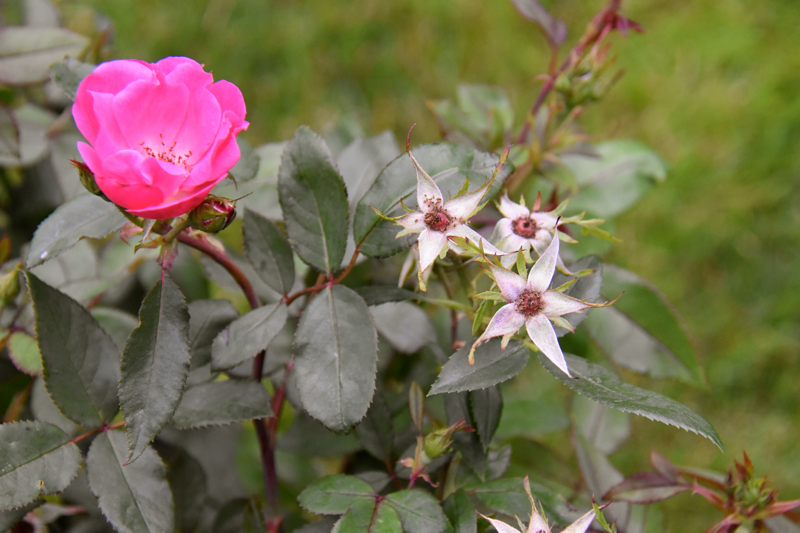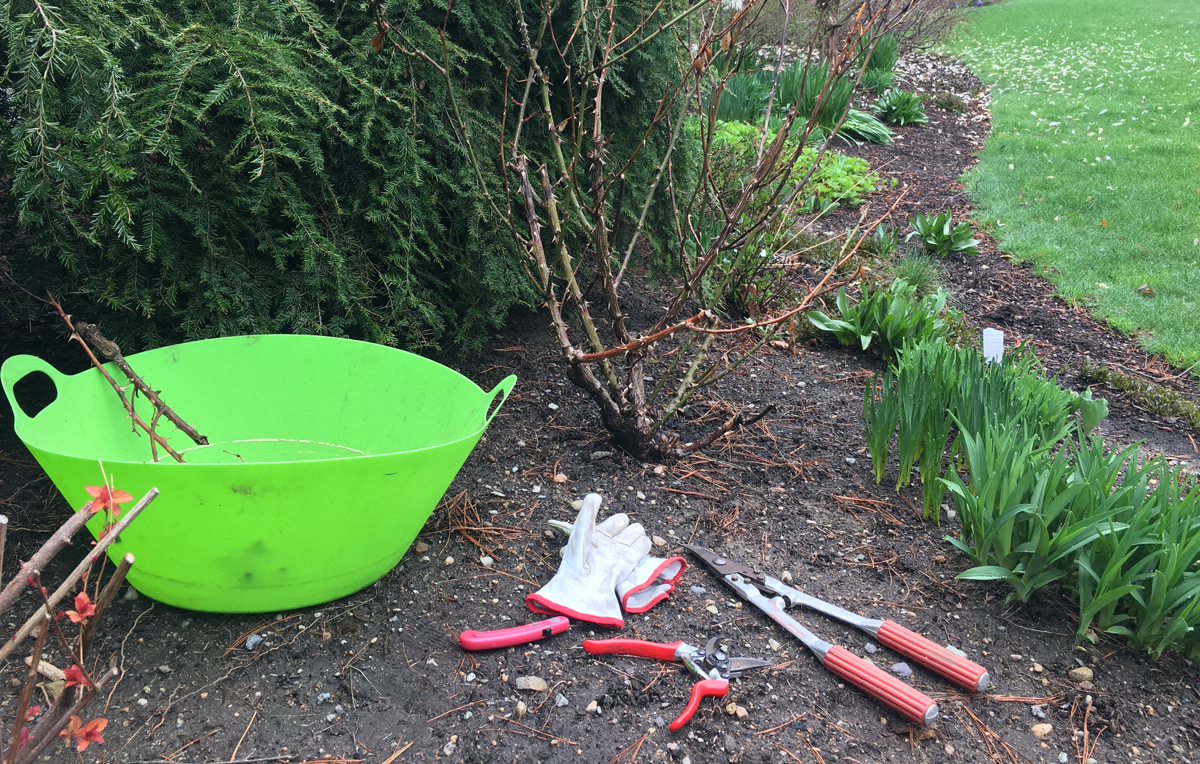Roses can be intimidating for many gardeners. After all, roses, in their seemingly infinite variety, attract the most ardent flowering plant enthusiasts, bolstered by an enormous body of literature full of detailed advice about how to best grow and care for these ancient and treasured blooms.
The truth, though, is that roses are tough customers that can stand up to a good pruning and even tolerate mistakes more readily than many other plants. There are several types of roses to choose from, each blooming slightly differently:
- Floribunda – bloom best on new wood
- Grandiflora – only bloom on new wood
- Hybrid Tea – only bloom on new wood
- Modern Shrub Rose – repeat bloomers through the growing season
- Climbers – can be repeat bloomers (not all)
- Ramblers – only bloom once a year
Why bother pruning?
Because pruning is vital for plant health. Pruning helps protect against diseases and encourages continued blooming for the types of roses that will repeatedly set buds. Of course, pruning also helps shape the plant and opens up the interior of it to promote healthier, more productive growth. Improving air circulation through the center of the plant helps dry the leaves which prevents foliar diseases; good circulation also prevents fungal diseases such as black spot and mildews, which are more common on plants with congested growth in the middle.
 Rose bushes that are not pruned will typically produce seeds, called rose hips, that will sap energy from the plant and prevent it from producing as many buds. If you leave the spent flowers on the rose bush at the end of the season, you should see small, berry-sized, reddish seed balls left on tips of the stems. Rose hips are actually ornamental, looking like small crabapples. Some gardeners prefer to generate rose hips -- they make great jellies, sauces, syrups, soups and seasoning, and birds like them, too.
Rose bushes that are not pruned will typically produce seeds, called rose hips, that will sap energy from the plant and prevent it from producing as many buds. If you leave the spent flowers on the rose bush at the end of the season, you should see small, berry-sized, reddish seed balls left on tips of the stems. Rose hips are actually ornamental, looking like small crabapples. Some gardeners prefer to generate rose hips -- they make great jellies, sauces, syrups, soups and seasoning, and birds like them, too.
 Pretty blossoms and spent blossoms - or "dead-heads" - that will form seeds - or "rose-hips".
Pretty blossoms and spent blossoms - or "dead-heads" - that will form seeds - or "rose-hips".
For the sake of this blog post, though, we’re going to stick to our strategy of pruning to encourage buds and blooms. There are different pruning strategies for different times of the year, but overall the goal is always the same: to keep the plant vigorous and open to encourage healthy growth and minimize potential problems.
Basic rose pruning involves removing dead, damaged, or diseased branches. As a good rule of thumb, deadwood should be pruned out, no matter what time of year it is. Healthy branches will be pure white or light green when cut -- any discoloration is a sign of dying tissue and should be cut out.

Damaged or diseased wood is also easy to spot, and often go hand-in-hand because damaged areas tend to create entry points for diseases. In roses, damage often occurs on crossing branches, where wind causes thorns to rub against adjacent canes. Wind damage can also occur during the main growing season when bloom-heavy branches snap during stormy weather. Diseased branches are usually victims of some type of stem canker or lesions from fungal diseases such as black spot or mildews, and should be removed promptly to prevent the pathogen from spreading.
There are four main types of pruning:
Spring Structural Pruning – Ideally done to shape the plant once the threat of frost is past, spring pruning removes deadwood and any damaged or crossing wood that wasn’t managed in the fall or that died back over the winter. In New England, we like to say prune when the forsythia are in full bloom, but watch the weather anyway, just in case there’s a cold snap forecast. Better a late pruning than too early and suffer unnecessary dieback.
Summer Pruning – cut lower than at the first leaflet to manage growth and shape. This is especially useful for aggressive growers like climbers and some shrub roses. Both deadheading and shaping can be done from June through September.
Deadheading – Good for all roses – single bloomers and multi-bloom plants. For single bloomers, if you would like, you can leave the finished blossoms to encourage the rose hips for interesting fall color and texture. When deadheading, make the cut at the 1st set of leaves that have five leaflets on the stem. Normally this is the second or third set down the stem.
Shoot pruning – coming from above the graft is a good thing – cut it down to fit in with the rest of the rose shape. If the shoot is coming from below the graft or bud-union, then you want to fully remove this growth because it’s most likely coming from the rootstock which is not the hybrid you purchased.
Here are some basic tips for good, general pruning:
- Make your pruning cuts at a 45-degree angle, about 1/4 inch above a bud of an outward-facing leaflet. By pruning at a leaf with 5 leaflets, the buds will grow branches that will produce more flowers. Pruning above that, where there are only 3 leaflets on the stem, will produce non-flowering stems, or “blind wood.”
- Choose an eye on the outside of the cane and slope the cut down and away on the opposite side. This allows excess natural sap to rise and seal the cut without interfering with the developing eye. Pruning to an outward-facing bud also promotes outward growth, opens up the plant to air circulation, creates more pleasing shapes, resists disease, and prevents the canes from becoming a tangle. Cuts closer to the eye than 1/4 inch may damage it. Cuts higher than that will leave a visible stubble -- a haven for both pests and disease.
- If the rose bush has foliage present, the location for your cut is easy to spot. Where there is no foliage to guide you, find the dormant eye by locating where the foliage was once connected. The eye is normally visible as a slight swelling above the surface of the cane.
- Use this same pruning technique when cutting stems for display and when removing spent blooms. In general, look at the overall shape and health of the plant, but begin pruning from the base of the plant. Remove any weak or twig-like branches thinner than a pencil.
- Take care of your tools Buy the best pruning tools you can find. Bypass pruning shears are best because they cut cleanly using a cutting blade against a non-cutting edge. For larger plants, you’ll also need bypass loppers and even a small saw for large rose bushes. Good puncture-proof gloves and a bucket will keep your hands safe and your trimmings organized.

TWEETABLE TIP
It’s time to tend those roses! Roses are tough customers that can stand up to a good pruning and even tolerate a few mistakes more readily than many other plants.
VIA @GardenContinuum

Remember to sharpen your pruning tools periodically -- either do it yourself or have an experienced or professional sharpener do it for you. Also, wipe your tools after each use with a soft, lightly oiled rag to prevent rust. Store tools in a dry area.
Armed with the knowledge you just picked up here, you’re now ready to confidently take on the task of nurturing roses in your garden. It’s easier and less risky than you might have thought. Like anything else, practice makes perfect. So go ahead, pick up a pair of shears and give it a try. It’s okay to make mistakes – your rose bushes will forgive you. Remember, it’s better to have a healthy, blooming plant that may experience a rough cut or two than one that, without any pruning, will grow increasingly weak and unattractive.





 Pretty blossoms and spent blossoms - or "dead-heads" - that will form seeds - or "rose-hips".
Pretty blossoms and spent blossoms - or "dead-heads" - that will form seeds - or "rose-hips".



Leave a comment